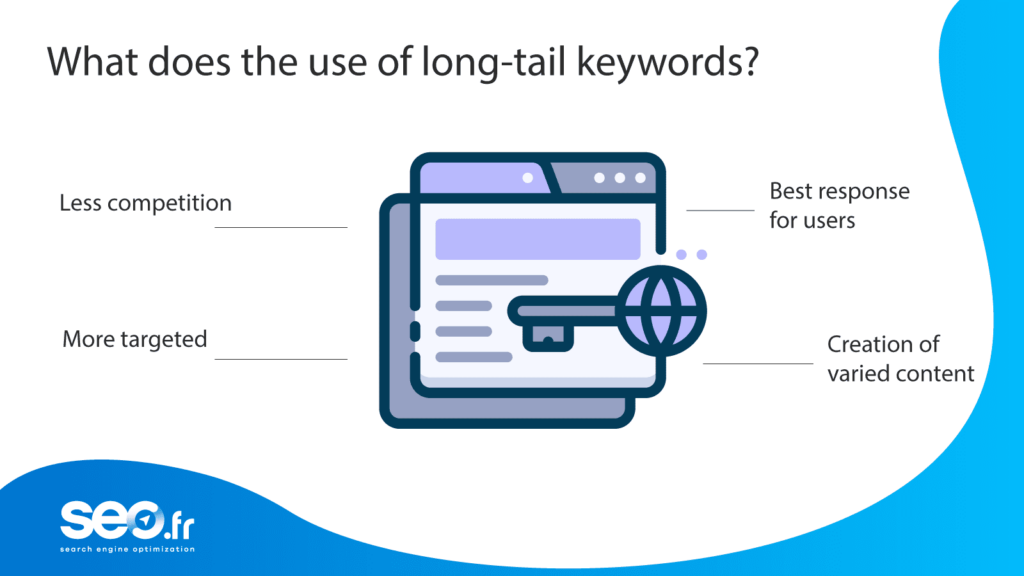SEO is like a jungle. Competition is fierce and only the relevant and important sites hold the reins. In this competitive environment, if you target general terms to position your niche site, you reduce your chances of appearing in the first search results. So what can you do to stand out from the crowd and gain a higher ranking in the SERP? You need a good keyword strategy.
Keyword research remains a cornerstone of any successful SEO campaign. When your site does not yet have a high level of authority, it is best to choose relevant and specific terms. Find keywords with a low level of competition. Although they have a lower search volume, they allow you to generate qualified traffic and increase your conversion rate.
Would you like to know all about the advantages of using the right words for your site’s natural referencing? Find out from SEO.fr how to maximize your visibility by targeting niche keywords.

What does the long tail mean in SEO?
The SEO long tail is a visibility strategy that enables you to position yourself on search engines. It includes the use of relevant and specific terms resulting from combinations of three or more words.
It is based on a low-competition key expression that web users use to refine their search for content on the web. The long query allows users to formulate their intention clearly.
In other words, this concept is opposed to generic keywords, which are competitive keywords. It enables you to rank your site favorably in search results.
Let’s say you’re developing an e-commerce business. You sell dresses, and your main keyword will be “dress“. That’s pretty broad and generic, don’t you think? However, to target and reach a given audience, you can exploit relevant terms such as :
- “Cheap wedding dresses”
- “Simple chic wedding dress”
- “Chic and classy wedding dress”
- “Chic and glamorous wedding dress”
As you can see, the long tail by definition refers to niche keywords. It targets a market segment, reaches a specific audience and presents them with relevant products.
But what’s in it for SEO?
The long tail is an SEO strategy for positioning a website in the SERP to generate potential traffic. It’s a solution that can be particularly beneficial for your site’s visibility. Why should you do this?
Because choosing specific terms means targeting the relevant queries that people search for when they want a precise result. You position yourself on the keywords on which Internet users can find you. This can sometimes generate more traffic to your web pages or blog posts than the main keyword. What’s more, long queries are less competitive.
You can therefore position your website easily in the first Google search results with the long tail SEO. Last but not least, using specific key terms helps you to target the right people. The result? You find qualified traffic and increase your customer conversion rate.
Niche keywords are useful in SEO, but also in paid search. When you use long expressions for your Google Adwords campaigns, you get much lower costs per click (CPC) because the competition is low. In other words, buying specific keywords is cheaper than buying general terms, which are expensive and highly competitive. You get a good return on your investment because your Adwords advertising generates a large number of potential customers.
Got an SEO question?
Geraldine can help
5 years of SEO expertise

What are the advantages of using niche keywords to position your website?
Long tail keywords add value to your brand’s visibility on the web. When you include them in your SEO strategy, you optimize your chances of appearing on the first pages of Google searches. Why is that?
- You have less competition. In contrast to generic key terms, which are highly competitive and only relevant, authoritative sites manage to rank, specific keywords are used less frequently. They give you the opportunity to rank your web pages and stand out from the competition.
Note that it’s not the same thing to position yourself on the key term “ballet dance“, which has 12,100 search volumes, and “ballet classes“, which has 720. Or “adult ballet classes“, which has 260 search volumes. (Data collected on Ubersuggest).
- With specific keywords, you can achieve a better conversion rate and increase your sales. How is this possible? It’s simple: users who enter relevant and precise queries know what they want. They are more likely to buy your products or services.
- When you optimize the referencing of pages on specific queries, you can use the links (this will allow you to play on your link building) from the latter to boost the SEO of pages centered on short-tail keywords.
- Positioning yourself on long-tail keywords helps to reduce your website’s bounce rate. You provide content with high added value that corresponds to the questions asked by web users. At the same time, you will attract search engines, which will improve your positioning. What’s more, long key phrases provide relevant results for voice search.
What are the disadvantages of using specific keywords for SEO?
The SEO long tail is certainly a way of ranking and generating qualified traffic, but it has one major drawback. It has a fairly low search volume. This can often affect the number of visitors to your site.
Bear in mind, however, that this problem does not arise in all cases. If, for example, you are targeting a specific product that is very much in demand in your sector of activity, you won’t have to worry about traffic to your shop window.
So you need to master the best tools and tricks for finding the right words for your niche. This is even more important when your site is not yet popular. Once you have succeeded in your word search, you can work on your key terms by creating quality content.
How do you find your niche keywords to rank in the SERP?
There are many proven methods for identifying long tail keywords. Let’s take a look at the best keyword research tools right now.
- Google suggest: available in the browser toolbar and on the Google search engine page, this feature focuses on predictive search. You can use it to obtain search-related suggestions for a specific query as you type. How can you use it?
Type a potential keyword you want to rank for into the Google search box, and you’ll see a drop-down list of related keywords searched for by Internet users. You can also add any letter after your key search term to get more interesting suggestions.
- Google’s other questions option is also a valuable source for finding excellent long terms.
- The keyword planner for Adwords advertising, also known as the Google keywords planner. This tool enables you to search for and identify relevant and interesting words. It gives you the search volume for key terms. This gives you ideas for positioning your niche site.
- Keyword Magic Tool is a Semrush tool that makes it easy to find keywords with high added value for your natural referencing. As soon as you enter a general root keyword into the tool, it generates a multitude of key terms in a matter of seconds. This is a good SEO tool for finding long-tail keywords.
- Google Trends is a free tool used to detect changes in the number of searches made for a given keyword over time. You can use this Google service to discover and track the main trends for a keyword.
A few tips for working effectively with keywords
Finding SEO long tail expressions is simple. The hard part is knowing how to use them in the content of your web pages. So how do you do it? Discover the three-step method you need to put in place.
- First of all, use key phrases naturally in your sentences. This may seem difficult, as it is sometimes a combination of long, awkward keywords. However, you should be creative and adapt your key term to make your content easier to read. Bear in mind that the user experience is an important point for your site’s SEO.
- Next, integrate your keywords according to a well-defined strategy. Include them in the title and subtitles of your page. Remember to broaden the lexical and semantic scope of your content and fill in the meta-description.
- Finally, consider the user’s search intent. Long tail SEO is good, but responding correctly to the search intent of your long tail key term is even better. Create quality content that matches the search intent of your keyword.









